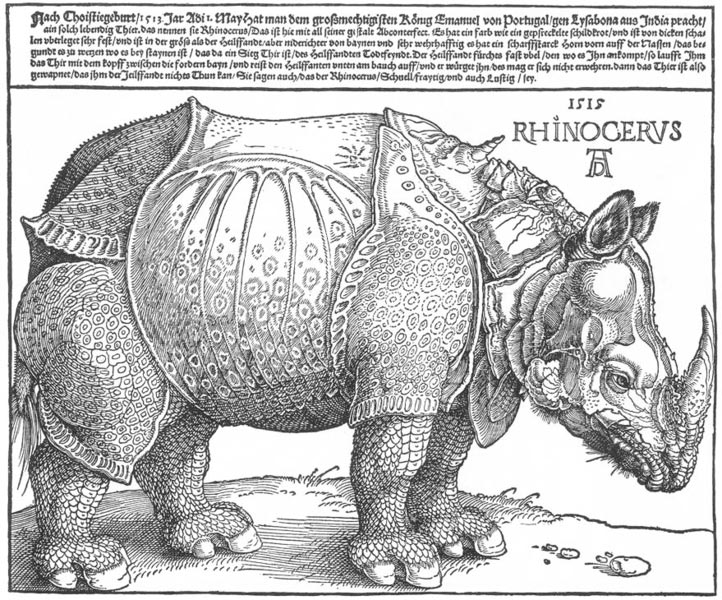| Rhinoceros | |
|---|---|
 |
|
| Artist | Albrecht Dürer |
| Year | 1515 |
| Medium | Woodcut |
| Location | British Museum, London |
| Dimensions | 8.4 in × 11.7 in |
| 21.4 cm × 29.8 cm | |
| Famous Paintings by Albrecht Dürer | |
| Young Hare | |
| Rhinoceros | |
| Adam and Eve | |
| Praying Hands | |
| Knight, Death and the Devil | |
| Apocalypse | |
| Self-Portrait of Albrecht Dürer | |
| Melencolia I | |
| Adoration of the Trinity |
Dürer’s Rhinoceros is a woodcut created by Albrecht Dürer in 1515 A.D. As an illustration of an animal at the center of a famous series of events, the woodcut was highly popular in the artist’s lifetime.
History
After the fall of the Roman Empire, Asian animals previously imported for circuses and gladitorial events became scarce or non-existent in Western Europe. In 1515 A.D., King Manuel of Portugal received a rhinocerous from his ambassador in Cambay. The animal had several different homes before drowning in a shipwreck. Dürer never saw the actual rhinocerous but worked from a sketch done by another artist.
Description
The print measures 8.4 inches by 11.7 inches and is a single animal figure with descriptive text in German above. Above the animal’s head to the right is printed “1515”, “Rhinocerus”, and the “artist’s monogram”, all on separate lines. The “u” in “Rhinocerus” is pointed like a v, due to typographical conventions of the time.
The rhinoceros is drawn as a four legged creature with scaly legs ending in three-toed, hoofed feet. Its body, while of similar shape to actual rhinoceroses, is depicted as covered in heavy horned plate. This plating also covers the animal’s haunches. The tail ends in a plume. The head is rhinoceros-shaped with elegant cupped ears and a very large nasal horn.
Technique
Woodcut printing came into widespread use in Western Europe in about 1400 A.D. The artist first draws the sketch on paper, and then the work is cut into a wood block that can be used to make multiple prints. Dürer usually worked on copper plates. It is speculated that he used the woodcut method for this print because it was more cost effective for a work that would see multiple printings.
After the events of Dürer’s Rhinoceros, another live rhinoceros would not be seen in Western Europe again for over fifty years. Even after more correct rhinoceros drawings were made, Dürer’s Rhinoceros remained popular. One of Dürer’s sketches of his Rhinoceros is housed in the British Museum.